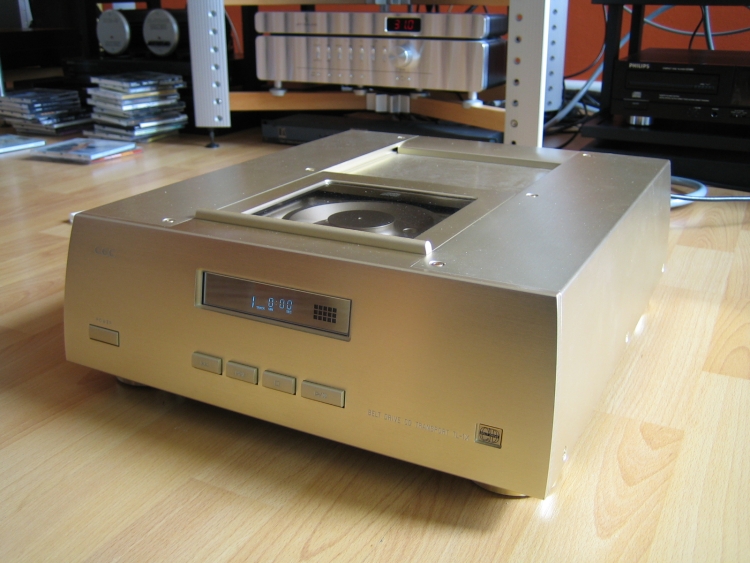
There are quite large differences in sound between CD transports…
Yes, even when you only use the digital output, still you can hear differences in speed, attack, fluidity. It seems incredible, especially since many engineers swear that this is impossible. Below are some well-known transports that have strong sound characteristics.
CMK-4 as used in the Teac T1
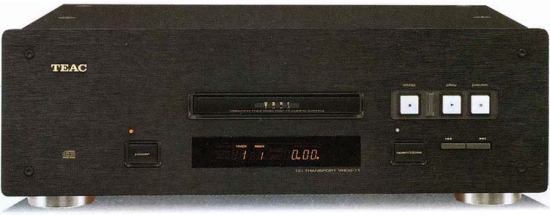
Above: an older audiophile favorite, the Teac T1. This machine is well-built, reliable and sounds excellent. It is still around on the second-hand market and good value. It uses the simplest VMK-4 VRDS transport of the time. One that is also used by entry-level models of high-end brand Wadia. That is probably why audiophiles like this machine; it is almost Wadia on the cheap.
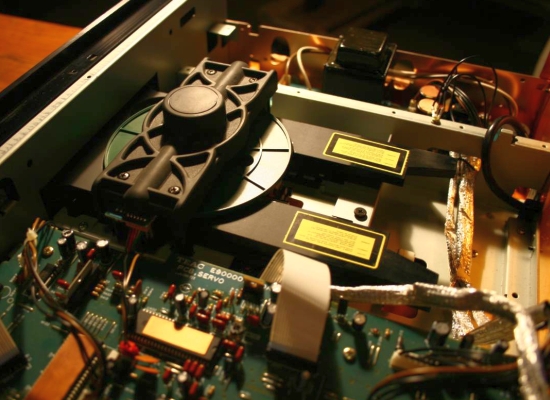
It certainly looks the part with its sturdy-looking centrally placed VRDS transport and separated power supply, digital section and output stages.
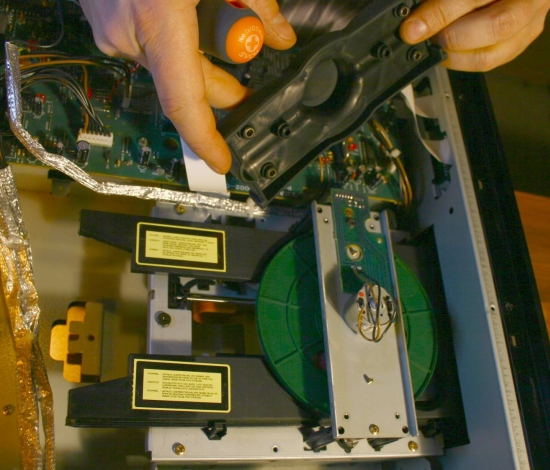
As you can see above, however, this transport is actually less robust as it first appears. (picture taken from www.lampizator.eu) The sturdy-looking bridge is actually just a plastic cover – for looks. Under that, is a simple pressed steel plate and a standard brushed motor.
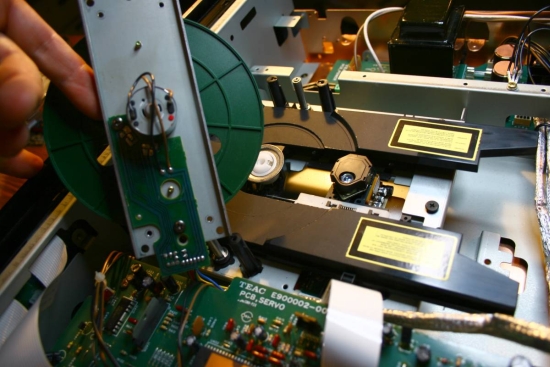
The green stabilizing platter is made from plastic, not metal and it is very lightweight and wobbly. This top section is the only part made by Teac. The rest is standard Sony, top-bottom reversed here and there. The motor went up, and the disc clamp went down. The laser is also standard Sony.
My friend Niels has a Teac CD transport with the same mechanism as is used above and in spite of the deceptively lightweight construction, it actually has some strong qualities normally associated with Wadia CD players and transports. Just to find out what would happen, he removed the plastic platter in such a way that CDs could still be played, and guess what? Most of that typical Wadia-boldness was now gone, replaced by a more upbeat but also more lightweight and less colorful sound.
I stumbled across the above inside pictures on another website and was amazed by the descriptions found there. (http://www.lampizator.eu/lampizator/REFERENCES/TEAC-T1/VRDS-T1.html) After reading this report I just couldn’t correlate it with my own findings. I’ve heard this mechanism (my friend Niels has a similar Teac player with the same mechanism) and it still sounds much like a Wadia transport! Don’t ask me how this is possible, seeing as everything else is Sony-made. Even the servo. But I swear: this thing does not sound like a Sony. I’ve had several Sony players and heard even more and you can always tell that it’s a Sony. Normally you can easily distinguish a Sony transport by its airy, agile and slender sound s well as sounding slightly mechanical. All Sony transports and cd player that I’ve heard had these characteristics. The Teac T1 sounds completely different: it is full, warm, solid, slightly dark and natural sounding. In fact, it reminds me a lot of how the Wadia transports sound. I’ve had several Wadia’s that used a similar transport and their sound has a lot in common with this Teac T1. It also has the VRDS tradeoff that the player has to run warm for a couple of cd’s every time, even when you leave it switched on 24/7, before it sounds its best. So is this difference caused only by the fact that the motor is upside down and that the disc is covered by a green plastic platter? I don’t know, but even though you might feel ripped off after seeing the pictures above, this is still an excellent player.
But don’t forget, this is only the cheapest VRDS transport available. There are much better ones further down the line that do have a full cast-metal bridge such as the CMK-3.2 and the improved SE version. And of course, there is the current all-out assault in the shape of the VRDS Neo.
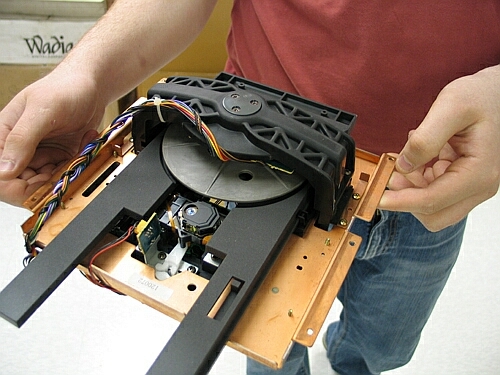
Above: Wadia 861 transport, Teac CMK 3.2
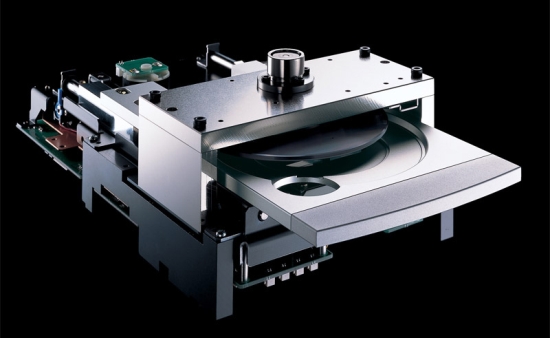
Above: VRDS Neo, produced by Teac, apparently only produced for Esoteric products
Philips CDM-1 and CDM-4 as used in various players
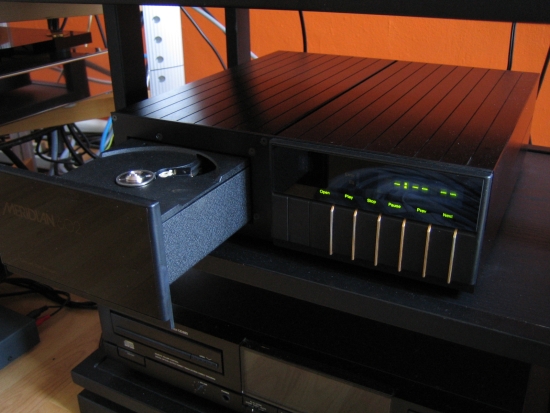
Above: Meridian 602. This was their reference transport at the time and it sure looks very chic. It also operates very smoothly; the drawer is both quick and silent. It uses the Philips CDM-4 transport, which is a more economical descendant from the CDM-1. It is still made from cast metal and it also sounds excellent but clever rethinking made it possible to reduce the amount of material used. A description of the 602 sound can be read further below.
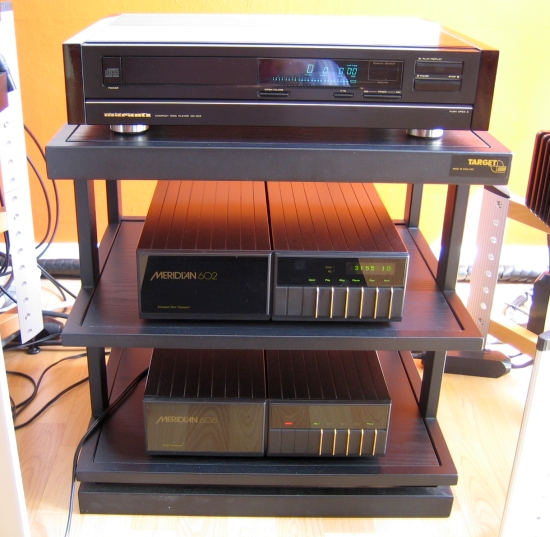
Above, on top of the rack: Marantz CD94MKII. It uses the CDM-1MKII transport. Since I had this player at the same time as the Meridian 602, I could easily compare the players. Of course, I used the digital output in order to listen only to differences in transport.
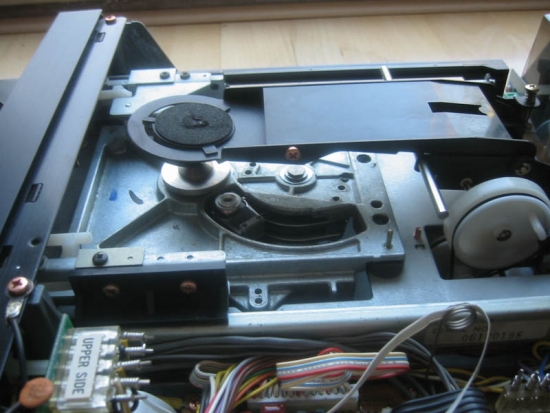
Above: the CDM-1 transport inside a Philips CD960 CD player. The same transport (and also a large portion of the electronics) are used in the Marantz CD94 and CD94MKII.
I’ve owned 2 Marantz CD94MKII’s, a Philips CD960, 2 Philips CD880’s and many other cd players that use a CDM1 as well as players that use the CDM-4 such as the Proceed PDT3, Krell KPS20i and the Marantz CD16. And I’m sure I left some players out. I guess you could say that I know a bit about these transports:-) As such, I am very familiar with their sound.
The old swing-arm mechanism is, in fact, an excellent mechanism. Many high-end brands used it until it was taken out of production because it was getting too expensive to make. After that, many brands were forced to start using the el cheapo CDM12 mechanism in its many guises. Granted, the CDM12 was far from bad, but it’s in a different league than the old swing-arm mechanisms.
What all Philips swing-arm mechanisms have in common are very subtle and fluid highs. The treble is so very smooth and velvety and the sound in general so natural and free-flowing that this transport is often solely responsible for any given player to sound “analog”. It doesn’t matter which brand you listen to; if the CDM1 is inside, it can never be an aggressive sounding player. Just why that is is unknown to me. I can imagine that the magnetically driven lens assembly is very free in its movement, unlike modern plastic worm-wheel mechanisms and the lens was made from glass instead of plastic.
The strange thing is that the 602 sounded mediocre at best. Sure it was subtle and never aggressive, but it sounded slow, rounded off and undynamic. I’ve heard this before in an older Marantz CD94. I think it is because of age. Transports do age and may start to produce more jitter or otherwise start to go off-spec. Whatever the cause, it is important to note that once you’re comparing 10-year-old transports, that age becomes a factor. I hope that this was also the case for the Meridian 602 because it was simply completely bettered by the Marantz CD94MKII on al accounts.
CEC TL1X Belt Driven CD Transport
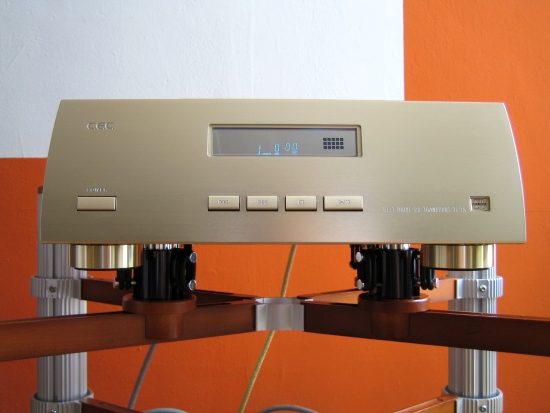
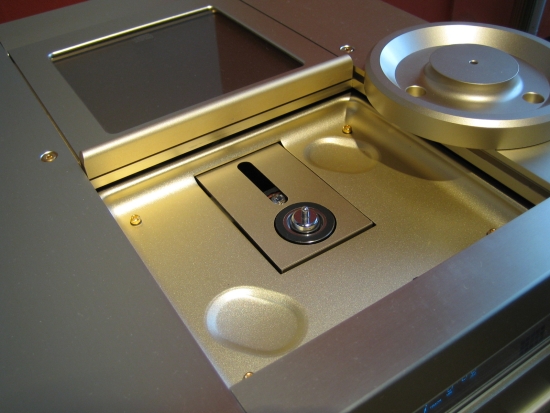
Above: the beautiful CEC TL1x Belt Driven CD transport. Not only the rotation of the disc is done by belt, but also the movement of the lens assembly.
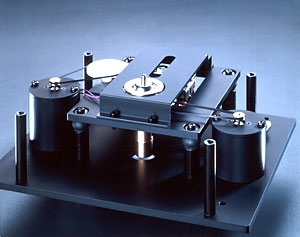
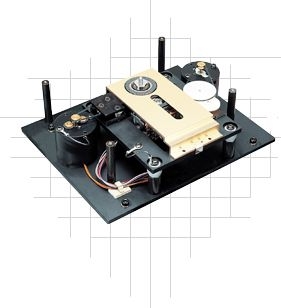
The use of rubber belts, heavy platters and counterweights in a digital player is controversial to say the least. For one, cd’s rotate at varying speed. Fast at the beginning and slow at the end as opposed to constant in a record player. This is why a counterweight is perceived as unnecessary and even unwanted in any disc reader. Rubber belts on their turn prevent the player to react quickly to changes in speed thus making the transport slower in response to starting up and track skipping. But according to CEC, these downsides are outweighed by the advantages which include less vibration transferred to/from the disc. But the proof of the pudding is in the eating.
The CEC sounds incredibly fluid and smooth, yet is very expressive, fast and dynamic. It bests the Marantz CD94MKII (CDM-1) in detail, focus, soundstage width and overall smoothness but the CD94MKII is actually a bit more fluid in the highs while being drier overall. The treble is drier but also more fluid. I know that sounds contradictory but this is how I hear it. The CEC is more continuous but hi-hats can be somewhat more coarse than on the Marantz. The CEC is my reference cd transport.
Philips CD-Pro 2 as used in various high-end players
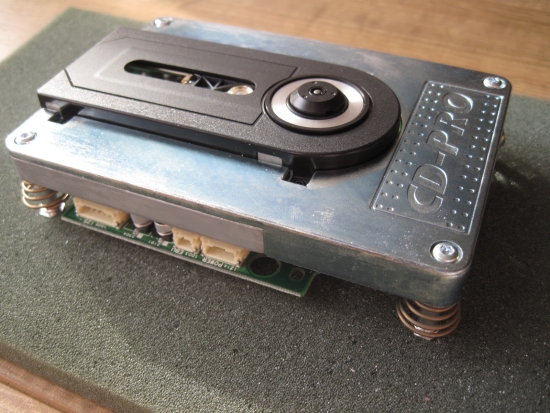
The original CD Pro and CD Pro 2 are well-known mechanisms and they have been used in a plethora of players such as Mark Levinson and Audio Research to name just two. Originally made by Philips themselves, the transport was produced under license by another company the name of which I can’t recall. You can distinguish the two by the Philips brand either being printed on the side or left out.
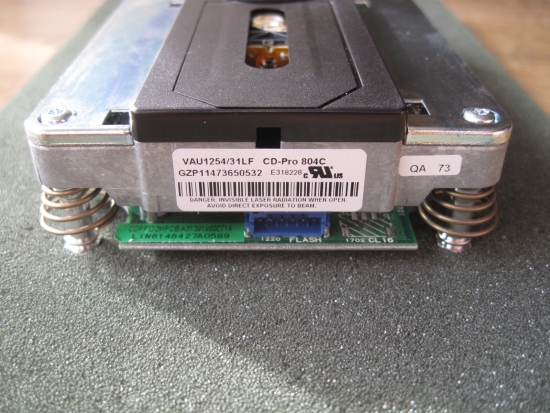
The above CD Pro 2 is a later non-Philips model. This is the transport that replaced the aging original Philips transport in my Mark Levinson 390S CD player. This change brought a very welcome improvement in PRAT, or to put it more precisely in terms of speed and dynamics. In spite of its heavy looks, the CD Pro itself is not a super high-end mechanism at all, but a very decent mechanism nevertheless. That it is one of the very few CD only mechanisms still available no doubt has helped in its success. Unlike the Teac (Sony) CMK 3.2 and Philips CDM1 and CDM4, the CD Pro mechanism does not have a long lifespan, usually lasting only 10 years. The interesting thing about the CD Pro 2, however, is that it is like a chameleon: it doesn’t have a specific sound and the end result can vary anywhere between smooth and clinical depending on the application.
So why do transports sound different?
Bits are bits, aren’t they? Well yes, and no. There are pages and pages you could write on this subject but it is largely abracadabra for me too. I do know enough about it to be able to put shine a light on this matter. First, you should know that there are many stages between the signal coming from the lens and the signal leaving the player in spdif form. These stages can all have their influence on the sound because in digital, timing is everything, and every time you change or modulate the signal you risk changing the timebase. Then there’s the precision of the clock is very important for the same reason. Also important is the precision of the rotation of the disk. The more it fluctuates, the more faults will be read and the more the error correction has to jump in. Which brings us to the matter of error correction. This is done in several stages, not just one overall correction. The output in spdif form has to be fabricated, it doesn’t come off cd that way. The IC that combines clock and data has an influence on the sound, as well as (the presence or absence of) a capacitor or coupling transformer in the spdif output. Simply put, you’re not only listening to the pure data, but also to many circuits that are in place after the signal has been read off disc. Actually, you can measure the presence of a capacitor and coupling transformer in the spdif output, so at least that part is no black science:-)
Transport Placement and aftermarket feet
This is also controversial and I can understand why. If the quality of any digital signal depends only on timing, why should different feet give a different sound? Well, maybe it influences the way that vibrations are conducted to the inner parts of the player hence causing the laser to mistrack. Or maybe there’s more to it than that. But I do know that feet make a large difference to the perceived sound. Soft rubbery feet make the sound soft and slow and hard cones make the sound more delineated and improve transient response.
Power cords and Digital Interlinks
This will hopefully not come as a surprise to you by now. After all, if you were a cynic you probably would’ve stopped reading by now:-) Indeed, power cables make a difference, even when connected to a transport. Why? I presume this is because they influence other components connected to the same extension block but this is just guessing. Digital interlinks also have an influence on sound by the way. With certain cables, you can make the sound faster and more dynamic or gentler and more fluid with other cables. Don’t assume that 1’s are 1’s and 0’s are 0’s. Of course, they are in principle, but here, timing is everything, and apparently the timing can be disrupted by cables.
Conclusion
Transports really do have their own sound signature and this is easy to hear. Look for differences in speed, attack, dynamics and fluidity. The differences are indeed not super-large, but absolutely clearly audible and, the CD Pro 2 aside, it is comforting to find that the mechanism’s inherent sound characteristics are usually audible irrespective of the player brand in which they are implemented.
Update May 2020
There is much more to say on this subject. In the meantime, I have learned more on the subject and I will definitely update the article if I find the time. I should also note that the proper adjustment of a CD mechanism is vital in getting the most accurate sound from it. Some of the players that I used may have gone off-spec, thus invalidating the results.
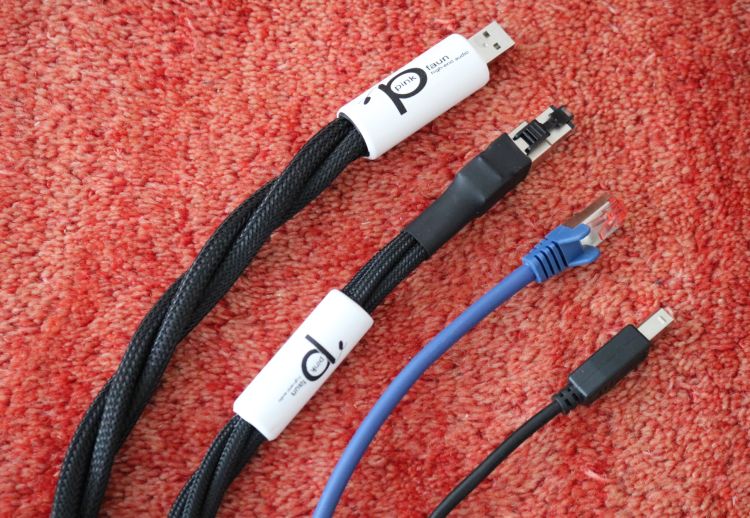
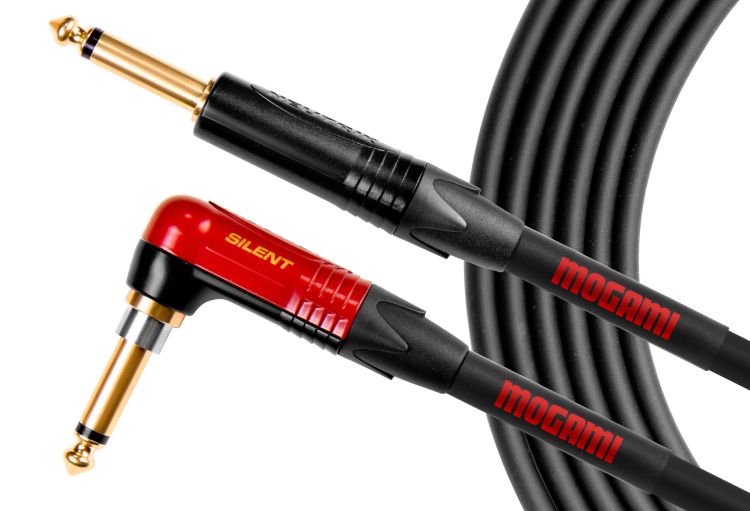
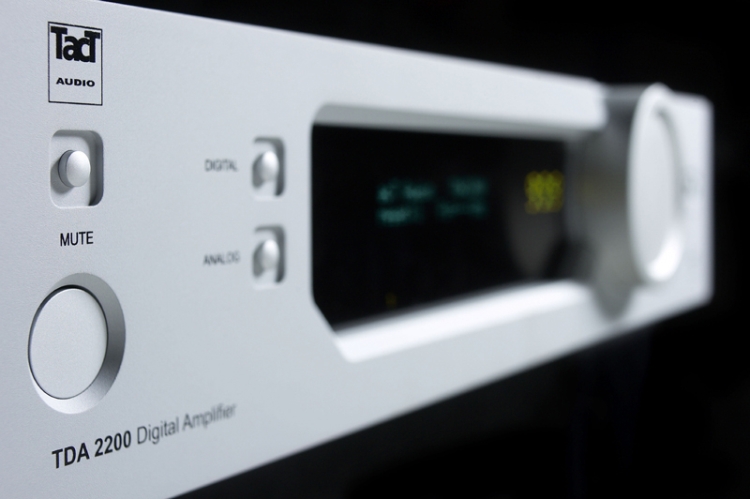


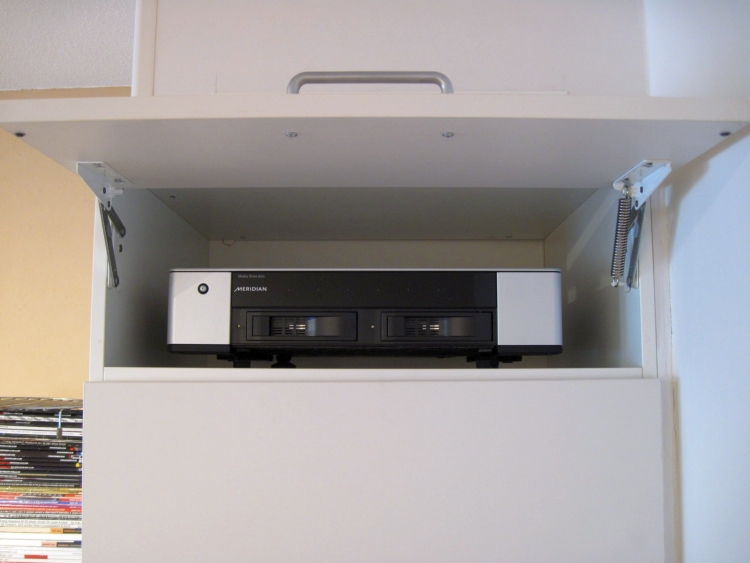
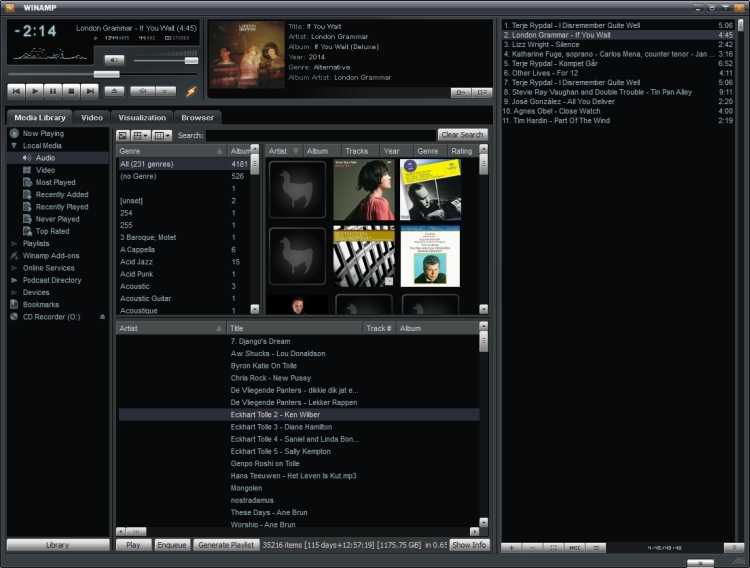
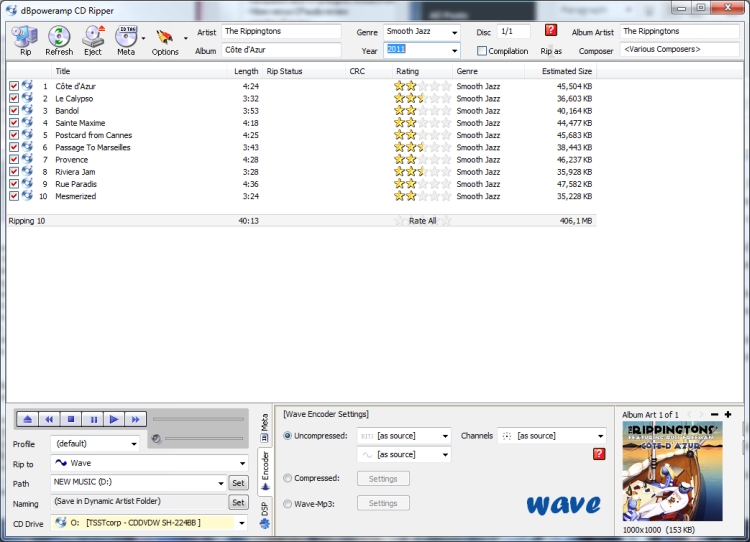
An interesting article that was going very well until the author lost all credibility by claiming differences in power cables. Do people realise the damage it does to their reputation. No one, I repeat, no one has ever been able to identify a difference in power cables. I will happily bet my house for the author’s house (all properly and legally agreed through solicitors), if the author can identify a power cable difference in a properly controlled test – a challenge no one has ever accepted. It is a shame that someone providing such useful information discredits themselves in the final furlong.
Hi Stevie, Meanwhile I have an idea why I hear differences between power cords even with CD transports, and I added this to the review. Differences between power cords in general are easy to hear. Especially when comparing a very smooth sounding cable such as a Furutech FP-TCS31 with a very clean sounding one such as a Belden 19364. If you agree to visit some day then I’d be happy to do a blind test with you. You can swap the cables and I’ll try to identify them. Actually I’ve already done plenty blind tests and have also tried to trick friends, to no avail. The only thing I am not sure about is WAV vs FLAC. Sometimes I think I hear differences, other times I can’t distinguish them. Of course, mathematically they should be identical. But real-time conversion inside a streaming endpoint is something else than controlled offline conversion on a computer and the results need to be 100% the same (but they might be). My point is that there may always be explanations that you just did not think of at first. In any event: I’m not making this up.
Are there any current cd transports on the lower end you think are any good?
Project, music fidelity, cambridge all do sub 1000 transports and I was wondering how they compare
Hi Richard, Alas, I’ve not heard any sub-1000 euro transports. The most affordable I’ve reviewed is the Jay’s Audio CDT-2MkII. Of the ones you mention, the Pro-Ject CD Box RS with its Blue Tiger mechanism could be very good and I find the RS-2 T to be especially interesting. Maybe I will look into it some day.
…and how can you explain why with Van den Hul the mainsstream powercord attached to my ATC SCM50ASL the sound was somehow a little muffled, less detailed and with more bloated bass than Siltech Explorer powercord? How can you explain the better fluidity and more clear micro- and macro-dynamics of the Siltech attached to the same SCM50ASL?
Great annylis of the old CD players and mechanics…..do you really choose a golden oldie over a current , positively reviewed machine ..?
So why do transports sound different?
Because HiFi Voodoo make it possible.
Digital data flow do not care the transport.
If you think it does, better visit some psychiatrist.
I understand why it would seem obvious that they wouldn’t. But if you’d just compare a couple for yourself, then you’d hear that they do. Yes, the data is digital, but it is being read in an analog fashion. There are certain variables in the readout process and we all know what jitter contributes. That’s the only well-known issue with digital that we have discovered so far. Who knows what parameters we will discover next?
Everything in a hi-fi chain is imperfect, this is why many factors can make improvements. Just because digital is 0s and 1s, doesn’t make it infallible. You can play a very scratched CD and as long it doesn’t skip, there will be many missing or incorrect bits of info. which you have no idea are wrong or missing. In other words, CDs play imperfectly most/all of the time but you are just not usually aware of it.
True but also incomplete. Don’t forget about the Cross-Interleaved Reed-Solomon error correction code that constitutes a large part of the data on a disc. Thanks to this coding the original data can be losslessly restored even when a lot of info is missing. Only when unrecoverable errors occur will the system start interpolating and if that also fails, ultimately, skip. I looked it up on Wikipedia for the fine details:
“The result is a CIRC that can completely correct error bursts up to 4000 bits, or about 2.5 mm on the disc surface. This code is so strong that most CD playback errors are almost certainly caused by tracking errors that cause the laser to jump track, not by uncorrectable error bursts.”
From many more experiments that I conducted lately I can deduct that the differences that we observe between CD transports are definitely not only related to read errors. These tests are ongoing but I’ll post a new article at some point in which I’ll dive more deeply into this.
Years ago I owned a high end store during Levinson’s heyday. We showed, and I owned, their Reference CD transport and DAC. 9 grand for the transport, 17 for the DAC. Quite expensive in the late 90’s. If a customer could only afford one of the two Reference pieces they usually wanted to go with the No. 30.6, the DAC. I tried, usually successfully, to save money for other things and go with the 9,000 transport and the $8,000 DAC. That combo was clearly better than the reverse. These days I’m using a $2500 Jay’s Audio, which is superb. No idea how they can build this, with the performance, fit and finish for this price, even in China.
definitely .
when i change transport from meridian 200 to teac p93.
i hear great difference. the meridian was much better.
You can’t hear a difference. You just think you can. Either the digital data is correct or it is incorrect and the builtin error correction fixes it so it is correct. If the error correction can’t fix it, you will get fairly serious audible glitches. It’s fairly easy to test this. Just compare the digital streams coming out of the transport. It will ematch the data in a wav or flac stream.
This response only shows that you never heard a high-end audio system
Your logic is not incorrect. But I’m afraid it is incomplete, focusing only on a single aspect of digital, and assuming error correction is inaudible. Even among bit-perfect iterations that appear glitch-free there are audible differences. Why? Because error correction and servo processes, and the effect they have on the power supply, are actually audible, and due due to interactions of the interfaces that affect other parts of the processes. Don’t forget much of the signal path is analog, even the digital signal itself. It is only its code that is digital. Then, there is the influence of noise, among other external influences. And this is only the influences that we know of. Alas, the premise was very promising but digital is not as perfect or immune as we hoped. But for many, it is indeed perfect enough. I will admit that we are not talking about absolutely enormous differences, but they sure are there.
Either the transport produces a correct digital stream on its digital output or it doesn’t. Given an error free read of the disc or a correctable read of the disc, If it doesn’t, then it is an incorrect implementation of red book.
Imagine a perfect world where digital was perfect. Well neither of these yet exist, or probably could ever exist. But we strive (and continue) to make both better, especially hifi, and in the face of those who claim it’s impossible.
The problem as I see it is that scientific and engineering types think the degree of understanding we now have of those subjects means that a hifi system can be fully understood by people with an advanced or even rudimentary understanding of science/engineering, and is relatively simple compared to more advanced technology like rockets into space. But what they fail to appreciate is that when a technology is created it is never made perfect AND, perhaps more importantly, it cannot necessarily be fully understood by conventional scientific understanding. I see no theory of hifi systems made to optimise sound quality in any science textbook or thesis. Some of the understanding will no doubt be in patents and maybe technical papers kept confidentially. But the common arrogance of scientists is that a hifi system is damn simple and thus we cannot learn anything from it, only tell audiophiles what is and isn’t possible, and discount their real experiences, which have been shown many times to not be explained away by confirmation bias or other cognitive distortions. Our brains and ears have powers beyond any supercomputer but also massive weaknesses compared to them. They are both different tools with strengths and weaknesses. I keep saying this, but this is why all serious hifi developers use scientific (objective) and hearing (subjective) tests.
The only reason hifi objectivists won’t listen is arrogance and being stubborn. But the irony is that in doing so, they are failing to adopt the most important of scientific principles: an open, enquiring mind. They are blinded by their hubris and arrogance. These disputes in hifi will probably go on indefinitely, such are people’s mental shortcomings. How ironic that the worst offenders choose to throw insults instead of examining their own arguments and logic.
Well I have a cheap dvd/rw transport I ripped out of a laptop several years ago and placed in an external box. This drive can read CDs at around 6 times the speed required for audio CDs.and generate error free wav files (or flac files if fed through the compressor). Are you suggesting that if I connected this up to a dac it would sound any different than your transports? Fair enough if that’s what you think but it doesn’t make sense to me.
Conventional wisdom used to be that all CD transports sounded the same, for the arguments still often cited. But then audiophile claims to the contrary we’re vindicated by the discovery of a phenomenon called jitter, or timing errors. Where was your science then?? Just one example of how objectivists make incorrect assumptions.
Marigo Audio Aida Mat made a big difference within my system. I also did several other tweaks on my transport which improved the sound. And no, I’m not imagining it. If the theory doesn’t support this, then the theory is inadequate. As people with an open mind and plenty of hifi experience say ‘everything can count in hifi’. It’s only closed minded skeptics or objectivists who love theory so much they discount real experience.
What many fail to appreciate is that there’s no such thing as a digital wave. Only an analog wave with a digitally encoded signal. Hence, there are many ways such a signal can be distorted. Jitter and added noise being just 2. I’ve also read that errors in reading don’t only result in perfect correction or nasty digital noise. They can easily result in signal distortion which simply makes the final result very slightly different, just like any other form of distortion.
Indeed: the digital code is relayed by a fully analog signal. Nevertheless, what people often have trouble reconciling with is that the signal output is error-corrected and re-timed, and can be proven to result in a bit-accurate stream. And yet, us audiophiles can still hear a difference. That’s the annoying part:-) I’ve had so many conversations with technicians and digital experts. Many of them won’t go along with what I say I hear, but some do, and a good explanations I heard is that the perceived differences could probably be measured, if we only knew how to measure them.
There can definitely be differences. I recently bought a Lector CD transport, the latest model. My other CDT is a jays audio cdt3 mk2. The Lector sounds obviously darker in sound, while also being incredibly detailed and natural sounding. It reminds me of an x-ray kind of presentation; everything is audible, but it’s a bit dark overall. How is that explainable? A Google search quickly revealed others have also found Lector to have a darker presentation. The difference is such that tracks which sounded glorious using the Jays sounded a bit lifeless and muted with the Lector. It’s organic and transparent but seems to lack musicality/soul. Was the Jay’s giving an artificial sheen to the sound? Why is this hobby so confusing at times? 😂 At this level of CD transport, you’d think the differences would be minuscule. I’m considering running both transports in parallel, because they each have excellent qualities but neither is completely superior to the other. The Jays won’t play some discs, that’s why I bought the Lector.
With transports, the sonic differences are caused in large part by the decoder, filter, and S/PDIF encoder building blocks that are used. The differences they incur can be very large indeed. Then, there’s the power supply and its filtering that can also have a large effect. Note that sometimes perceived effects, from instance from connected power supplies, can also be induced in the rest of the system.
I was surprised when I recently tried the relatively new TEAC vrds 701t transport to feed my Benchmark dac/pre.
Surprised because I preferred my old Sony dvp9000es as the transport.
The midrange on the TEAC was more forward by comparison.